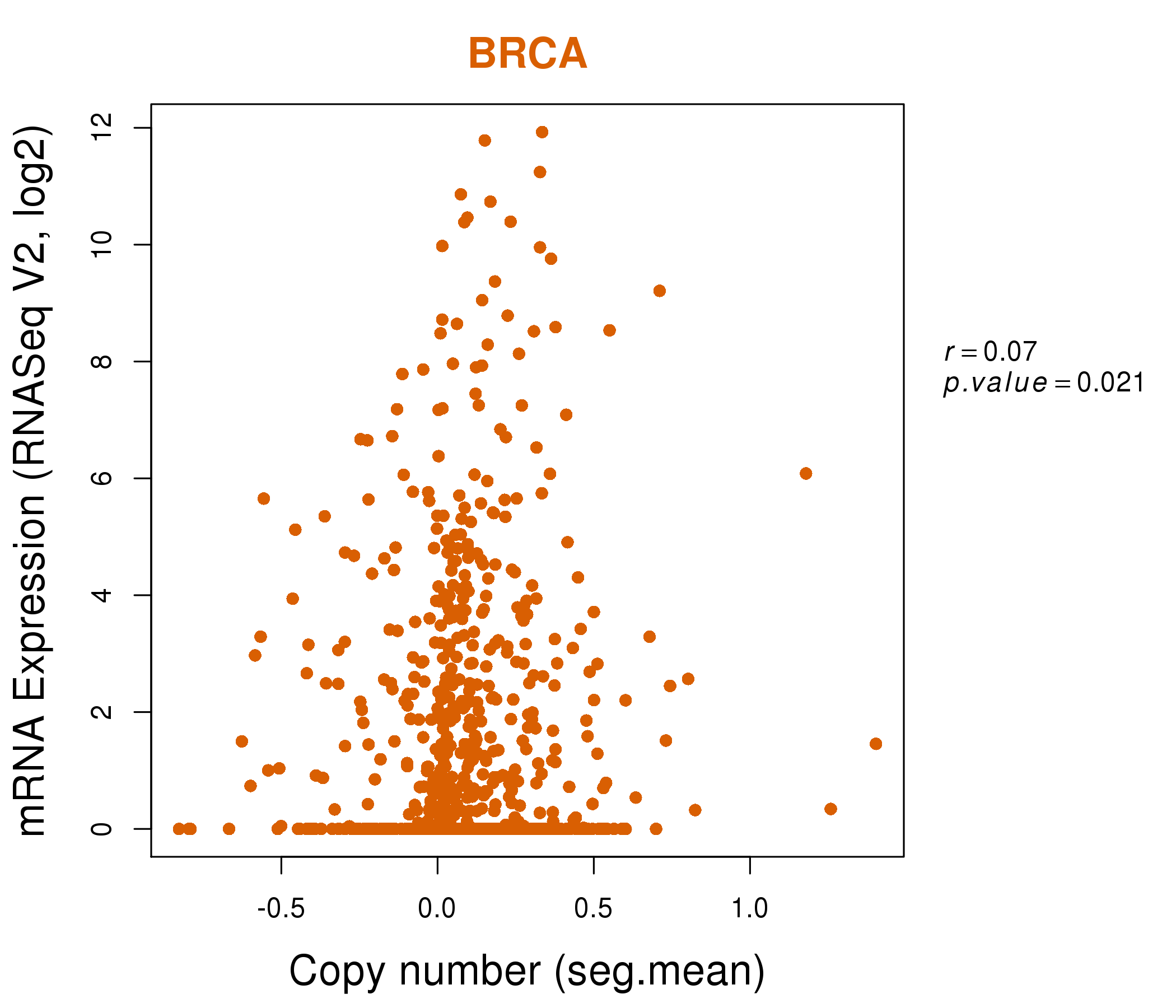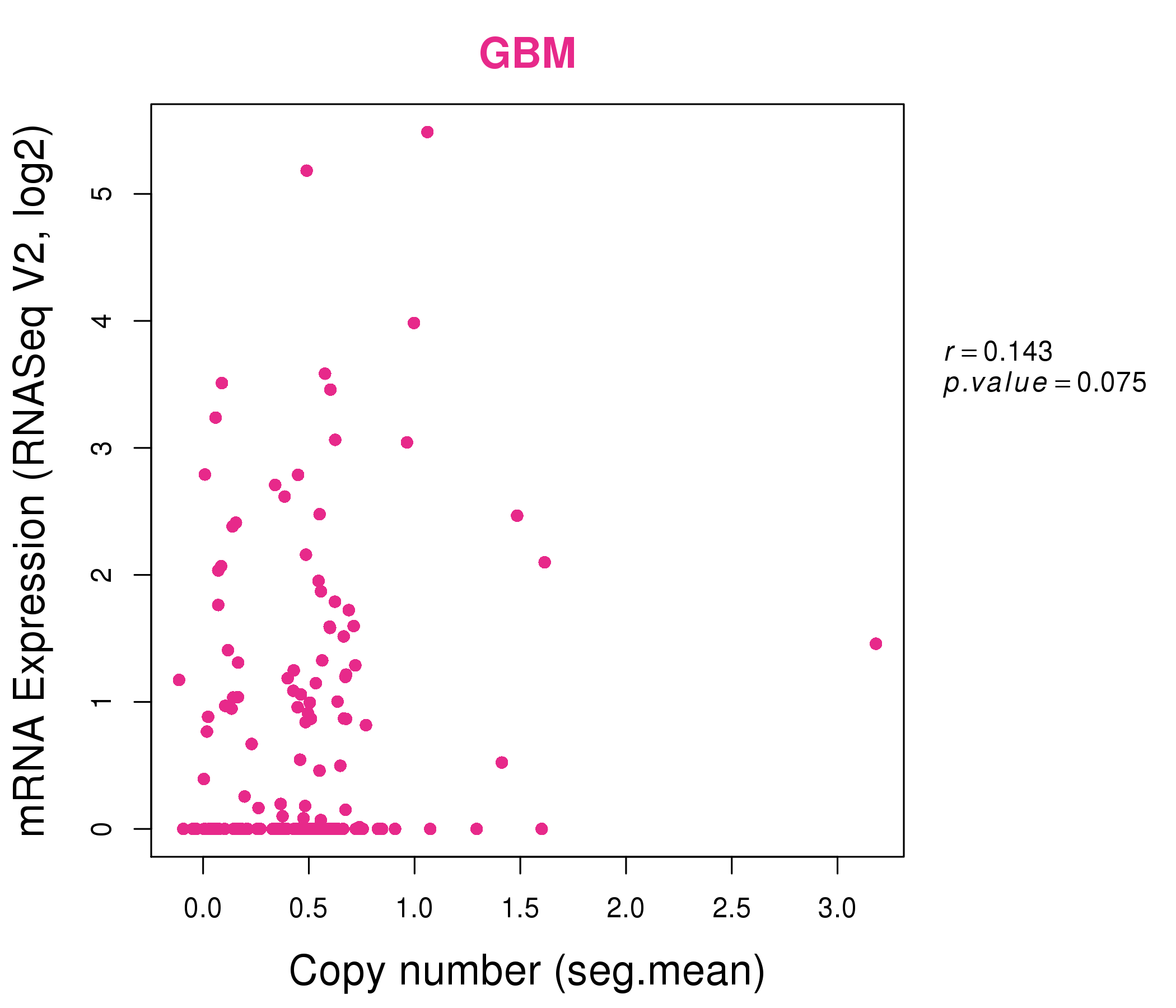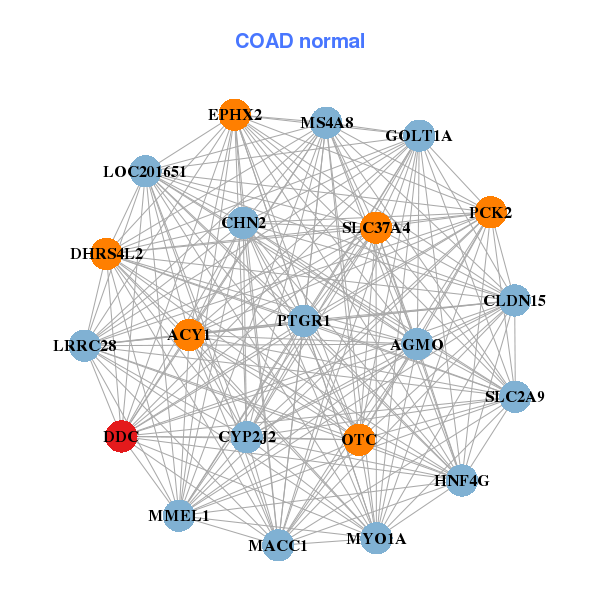|
|||||||||||||||||||||||||||||||||||||||||||||||||||||||||||||||||||||||||||||||||||||||||||||||||||||||||||||||||||||||||||||||||||||||||||||||||||||||||||||||||||||||||||||||||||||||||||||||||||||||||||||||||||||||||||||||||||||||||||||||||||||||||||||||||||||||||||||||||||||||||||||||||||||||||||||||||||||||||||||||||||||||||||||||||||||||||||||||||||||||||||||||||||||||||||||||||||
| |
| Phenotypic Information (metabolism pathway, cancer, disease, phenome) |
| |
| |
| Gene-Gene Network Information: Co-Expression Network, Interacting Genes & KEGG |
| |
|
| Gene Summary for DDC |
| Top |
| Phenotypic Information for DDC(metabolism pathway, cancer, disease, phenome) |
| Cancer | CGAP: DDC |
| Familial Cancer Database: DDC | |
| * This gene is included in those cancer gene databases. |
|
|
|
|
|
| . | |||||||||||||||||||||||||||||||||||||||||||||||||||||||||||||||||||||||||||||||||||||||||||||||||||||||||||||||||||||||||||||||||||||||||||||||||||||||||||||||||||||||||||||||||||||||||||||||||||||||||||||||||||||||||||||||||||||||||||||||||||||||||||||||||||||||||||||||||||||||||||||||||||||||||||||||||||||||||||||||||||||||||||||||||||||||||||||||||||||||||||||||||||||||||||||
Oncogene 1 | Significant driver gene in | ||||||||||||||||||||||||||||||||||||||||||||||||||||||||||||||||||||||||||||||||||||||||||||||||||||||||||||||||||||||||||||||||||||||||||||||||||||||||||||||||||||||||||||||||||||||||||||||||||||||||||||||||||||||||||||||||||||||||||||||||||||||||||||||||||||||||||||||||||||||||||||||||||||||||||||||||||||||||||||||||||||||||||||||||||||||||||||||||||||||||||||||||||||||||||||||||||
| cf) number; DB name 1 Oncogene; http://nar.oxfordjournals.org/content/35/suppl_1/D721.long, 2 Tumor Suppressor gene; https://bioinfo.uth.edu/TSGene/, 3 Cancer Gene Census; http://www.nature.com/nrc/journal/v4/n3/abs/nrc1299.html, 4 CancerGenes; http://nar.oxfordjournals.org/content/35/suppl_1/D721.long, 5 Network of Cancer Gene; http://ncg.kcl.ac.uk/index.php, 1Therapeutic Vulnerabilities in Cancer; http://cbio.mskcc.org/cancergenomics/statius/ |
| KEGG_HISTIDINE_METABOLISM KEGG_TYROSINE_METABOLISM KEGG_PHENYLALANINE_METABOLISM KEGG_TRYPTOPHAN_METABOLISM REACTOME_METABOLISM_OF_AMINO_ACIDS_AND_DERIVATIVES | |
| OMIM | |
| Orphanet | |
| Disease | KEGG Disease: DDC |
| MedGen: DDC (Human Medical Genetics with Condition) | |
| ClinVar: DDC | |
| Phenotype | MGI: DDC (International Mouse Phenotyping Consortium) |
| PhenomicDB: DDC | |
| Mutations for DDC |
| * Under tables are showing count per each tissue to give us broad intuition about tissue specific mutation patterns.You can go to the detailed page for each mutation database's web site. |
| - Statistics for Tissue and Mutation type | Top |
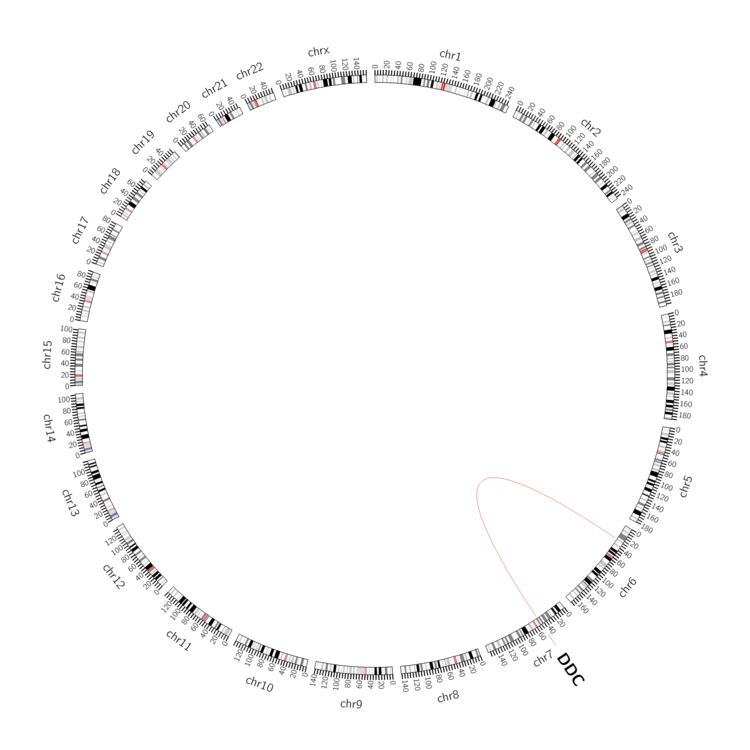 |
| - For Inter-chromosomal Variations |
| * Inter-chromosomal variantions includes 'interchromosomal amplicon to amplicon', 'interchromosomal amplicon to non-amplified dna', 'interchromosomal insertion', 'Interchromosomal unknown type'. |
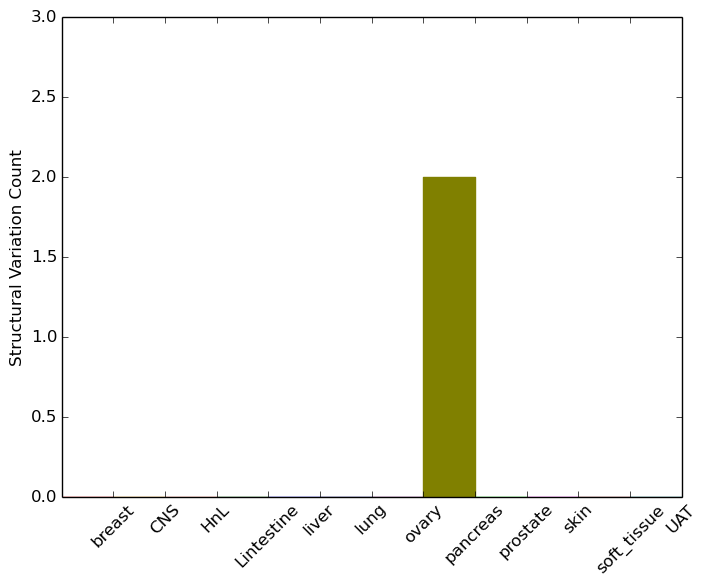 |
| - For Intra-chromosomal Variations |
| There's no intra-chromosomal structural variation. |
| Sample | Symbol_a | Chr_a | Start_a | End_a | Symbol_b | Chr_b | Start_b | End_b |
| pancreas | DDC | chr7 | 50573256 | 50573276 | chr6 | 29490618 | 29490638 |
| cf) Tissue number; Tissue name (1;Breast, 2;Central_nervous_system, 3;Haematopoietic_and_lymphoid_tissue, 4;Large_intestine, 5;Liver, 6;Lung, 7;Ovary, 8;Pancreas, 9;Prostate, 10;Skin, 11;Soft_tissue, 12;Upper_aerodigestive_tract) |
| * From mRNA Sanger sequences, Chitars2.0 arranged chimeric transcripts. This table shows DDC related fusion information. |
| ID | Head Gene | Tail Gene | Accession | Gene_a | qStart_a | qEnd_a | Chromosome_a | tStart_a | tEnd_a | Gene_a | qStart_a | qEnd_a | Chromosome_a | tStart_a | tEnd_a |
| Top |
| Mutation type/ Tissue ID | brca | cns | cerv | endome | haematopo | kidn | Lintest | liver | lung | ns | ovary | pancre | prost | skin | stoma | thyro | urina | |||
| Total # sample | 7 | 3 | 1 | 2 | 1 | 4 | 3 | 5 | 2 | 2 | 7 | 4 | 1 | |||||||
| GAIN (# sample) | 7 | 3 | 1 | 1 | 4 | 3 | 4 | 2 | 2 | 7 | 3 | |||||||||
| LOSS (# sample) | 1 | 1 | 1 | 1 | 1 |
| cf) Tissue ID; Tissue type (1; Breast, 2; Central_nervous_system, 3; Cervix, 4; Endometrium, 5; Haematopoietic_and_lymphoid_tissue, 6; Kidney, 7; Large_intestine, 8; Liver, 9; Lung, 10; NS, 11; Ovary, 12; Pancreas, 13; Prostate, 14; Skin, 15; Stomach, 16; Thyroid, 17; Urinary_tract) |
| Top |
|
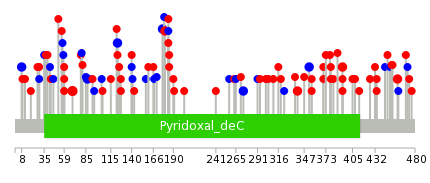 |
| Top |
| Stat. for Non-Synonymous SNVs (# total SNVs=59) | (# total SNVs=19) |
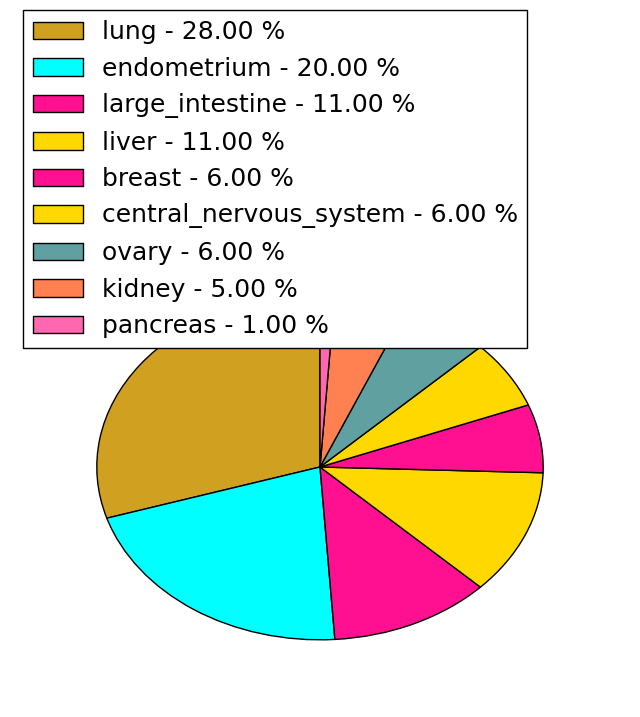 | 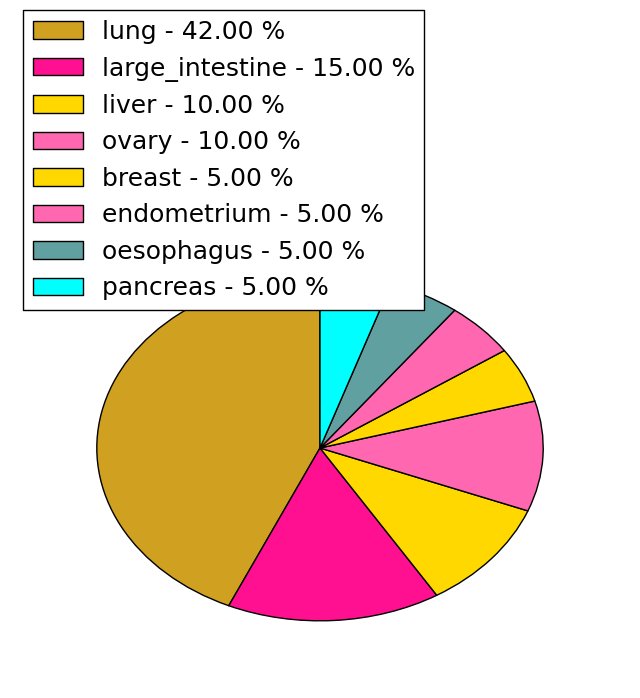 |
(# total SNVs=0) | (# total SNVs=0) |
| Top |
| * When you move the cursor on each content, you can see more deailed mutation information on the Tooltip. Those are primary_site,primary_histology,mutation(aa),pubmedID. |
| GRCh37 position | Mutation(aa) | Unique sampleID count |
| chr7:50607722-50607722 | p.T69M | 3 |
| chr7:50534976-50534976 | p.R393L | 3 |
| chr7:50537776-50537776 | p.R379S | 2 |
| chr7:50605624-50605624 | p.G123G | 2 |
| chr7:50611760-50611760 | p.R8R | 2 |
| chr7:50547491-50547491 | p.D339N | 2 |
| chr7:50566900-50566900 | p.Y274Y | 2 |
| chr7:50530997-50530997 | p.H459Y | 2 |
| chr7:50596925-50596925 | p.V184A | 2 |
| chr7:50596938-50596938 | p.M180L | 2 |
| Top |
|
 |
| Point Mutation/ Tissue ID | 1 | 2 | 3 | 4 | 5 | 6 | 7 | 8 | 9 | 10 | 11 | 12 | 13 | 14 | 15 | 16 | 17 | 18 | 19 | 20 |
| # sample | 3 | 1 | 6 | 2 | 5 | 3 | 5 | 8 | 4 | 1 | 19 | 5 | 10 | |||||||
| # mutation | 3 | 1 | 6 | 3 | 5 | 3 | 6 | 8 | 4 | 1 | 22 | 5 | 13 | |||||||
| nonsynonymous SNV | 3 | 1 | 4 | 3 | 5 | 3 | 4 | 6 | 2 | 11 | 5 | 12 | ||||||||
| synonymous SNV | 2 | 2 | 2 | 2 | 1 | 11 | 1 |
| cf) Tissue ID; Tissue type (1; BLCA[Bladder Urothelial Carcinoma], 2; BRCA[Breast invasive carcinoma], 3; CESC[Cervical squamous cell carcinoma and endocervical adenocarcinoma], 4; COAD[Colon adenocarcinoma], 5; GBM[Glioblastoma multiforme], 6; Glioma Low Grade, 7; HNSC[Head and Neck squamous cell carcinoma], 8; KICH[Kidney Chromophobe], 9; KIRC[Kidney renal clear cell carcinoma], 10; KIRP[Kidney renal papillary cell carcinoma], 11; LAML[Acute Myeloid Leukemia], 12; LUAD[Lung adenocarcinoma], 13; LUSC[Lung squamous cell carcinoma], 14; OV[Ovarian serous cystadenocarcinoma ], 15; PAAD[Pancreatic adenocarcinoma], 16; PRAD[Prostate adenocarcinoma], 17; SKCM[Skin Cutaneous Melanoma], 18:STAD[Stomach adenocarcinoma], 19:THCA[Thyroid carcinoma], 20:UCEC[Uterine Corpus Endometrial Carcinoma]) |
| Top |
| * We represented just top 10 SNVs. When you move the cursor on each content, you can see more deailed mutation information on the Tooltip. Those are primary_site, primary_histology, mutation(aa), pubmedID. |
| Genomic Position | Mutation(aa) | Unique sampleID count |
| chr7:50537852 | p.E89K,DDC | 2 |
| chr7:50605614 | p.G85G,DDC | 2 |
| chr7:50607722 | p.L275L,DDC | 2 |
| chr7:50605624 | p.T69M,DDC | 2 |
| chr7:50531072 | p.D395N,DDC | 1 |
| chr7:50597007 | p.R315C,DDC | 1 |
| chr7:50611697 | p.D193N,DDC | 1 |
| chr7:50537844 | p.L95F,DDC | 1 |
| chr7:50605628 | p.D59G,DDC | 1 |
| chr7:50530956 | p.A394A,DDC | 1 |
| * Copy number data were extracted from TCGA using R package TCGA-Assembler. The URLs of all public data files on TCGA DCC data server were gathered on Jan-05-2015. Function ProcessCNAData in TCGA-Assembler package was used to obtain gene-level copy number value which is calculated as the average copy number of the genomic region of a gene. |
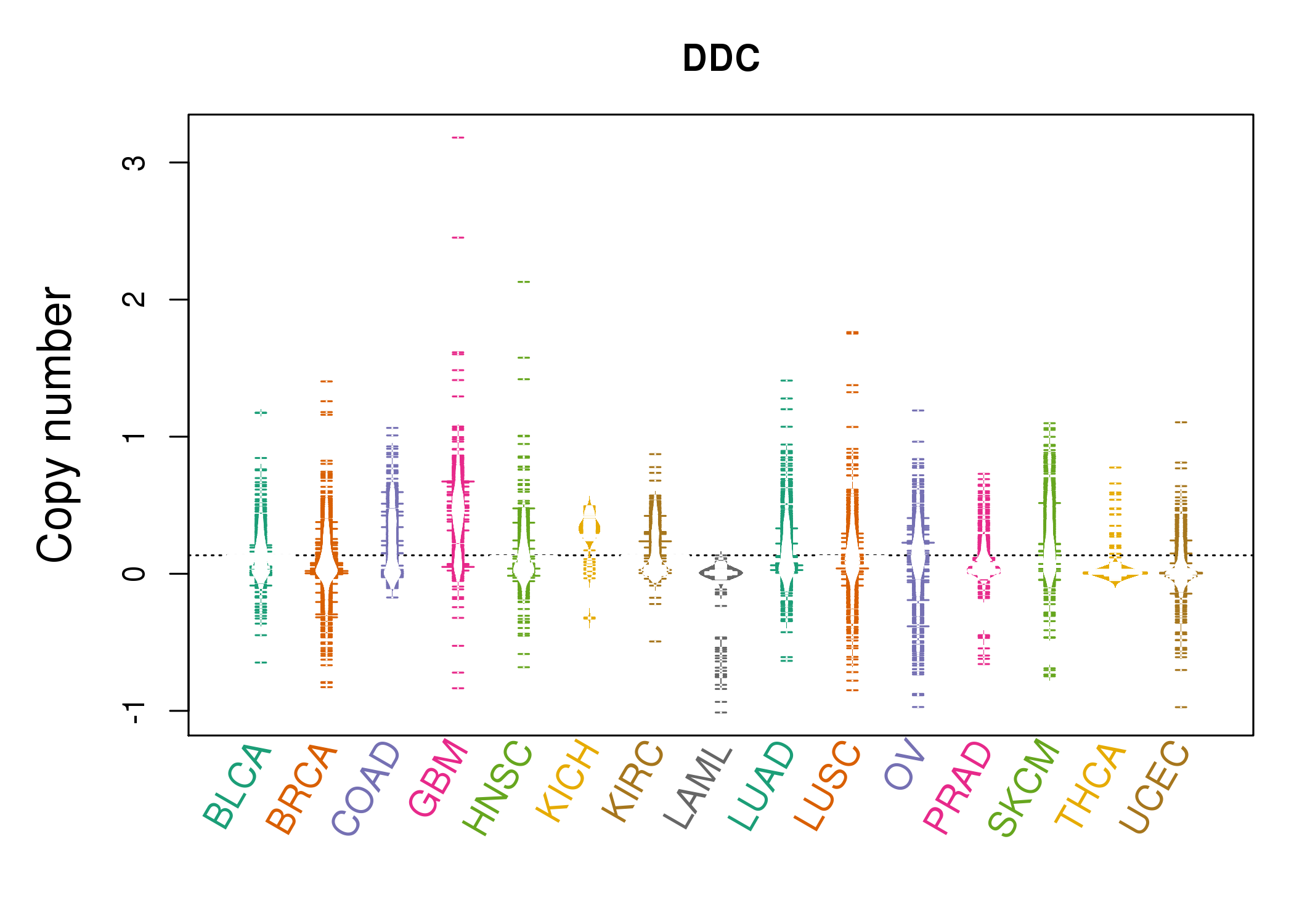 |
| cf) Tissue ID[Tissue type]: BLCA[Bladder Urothelial Carcinoma], BRCA[Breast invasive carcinoma], CESC[Cervical squamous cell carcinoma and endocervical adenocarcinoma], COAD[Colon adenocarcinoma], GBM[Glioblastoma multiforme], Glioma Low Grade, HNSC[Head and Neck squamous cell carcinoma], KICH[Kidney Chromophobe], KIRC[Kidney renal clear cell carcinoma], KIRP[Kidney renal papillary cell carcinoma], LAML[Acute Myeloid Leukemia], LUAD[Lung adenocarcinoma], LUSC[Lung squamous cell carcinoma], OV[Ovarian serous cystadenocarcinoma ], PAAD[Pancreatic adenocarcinoma], PRAD[Prostate adenocarcinoma], SKCM[Skin Cutaneous Melanoma], STAD[Stomach adenocarcinoma], THCA[Thyroid carcinoma], UCEC[Uterine Corpus Endometrial Carcinoma] |
| Top |
| Gene Expression for DDC |
| * CCLE gene expression data were extracted from CCLE_Expression_Entrez_2012-10-18.res: Gene-centric RMA-normalized mRNA expression data. |
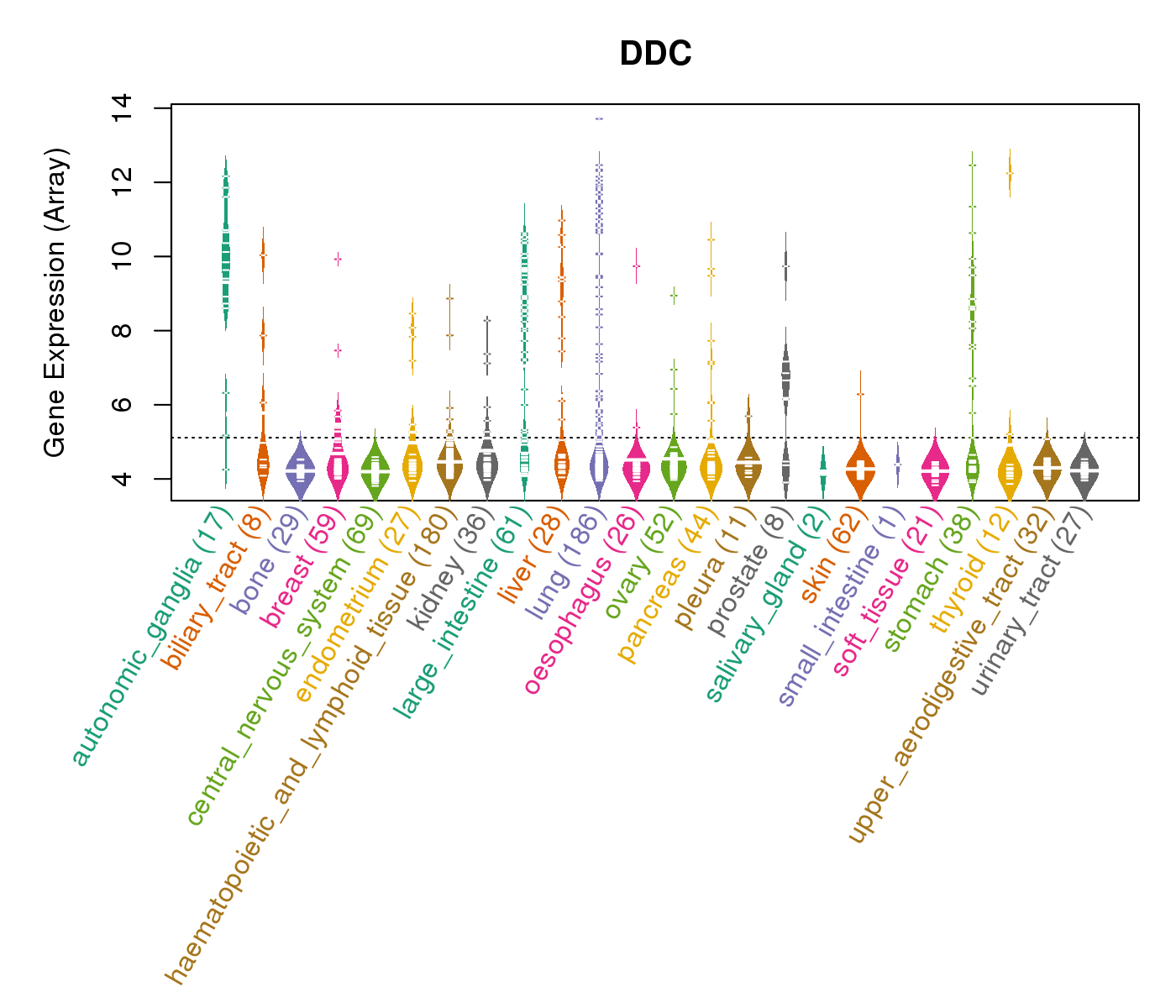 |
| * Normalized gene expression data of RNASeqV2 was extracted from TCGA using R package TCGA-Assembler. The URLs of all public data files on TCGA DCC data server were gathered at Jan-05-2015. Only eight cancer types have enough normal control samples for differential expression analysis. (t test, adjusted p<0.05 (using Benjamini-Hochberg FDR)) |
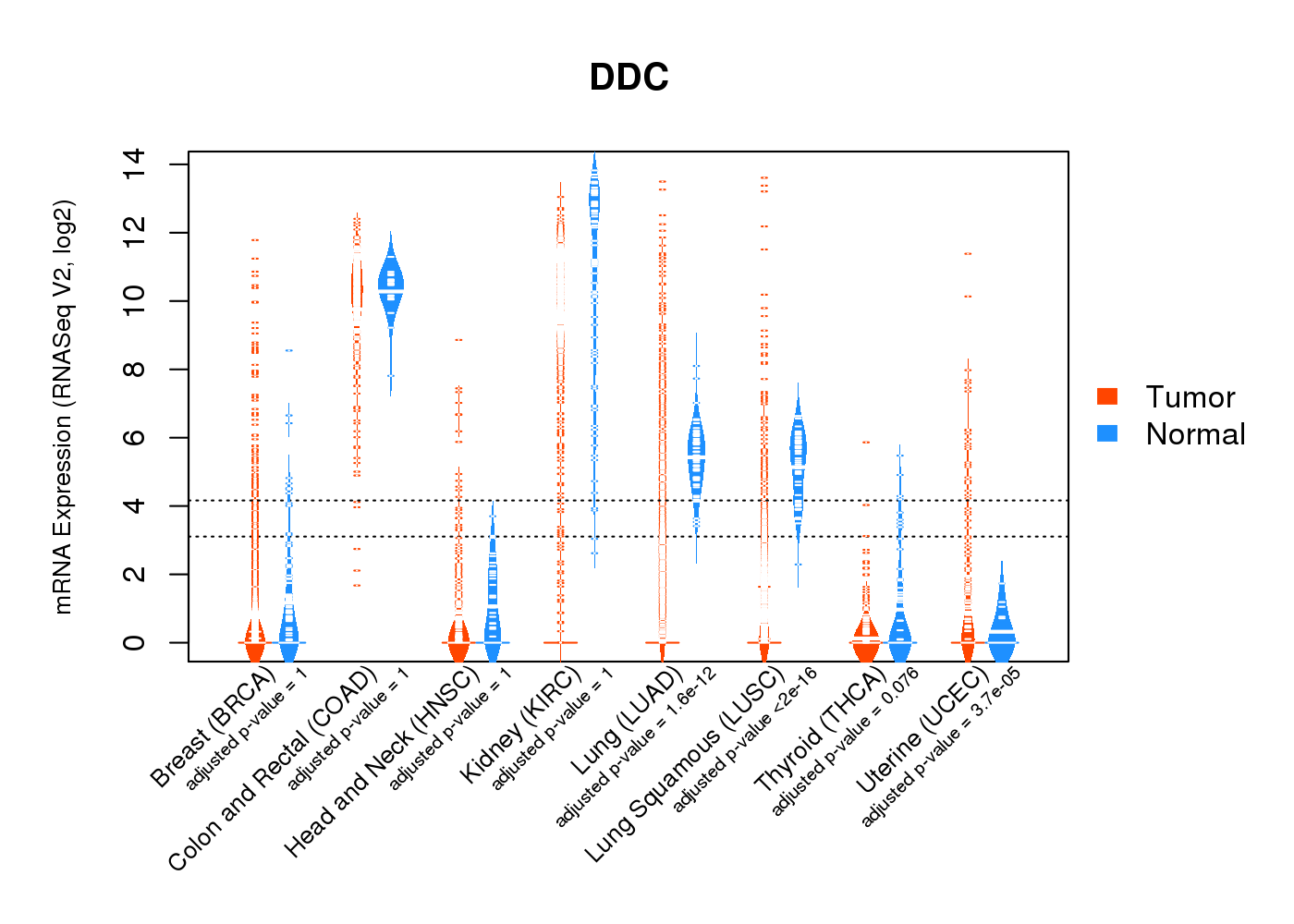 |
| Top |
| * This plots show the correlation between CNV and gene expression. |
: Open all plots for all cancer types
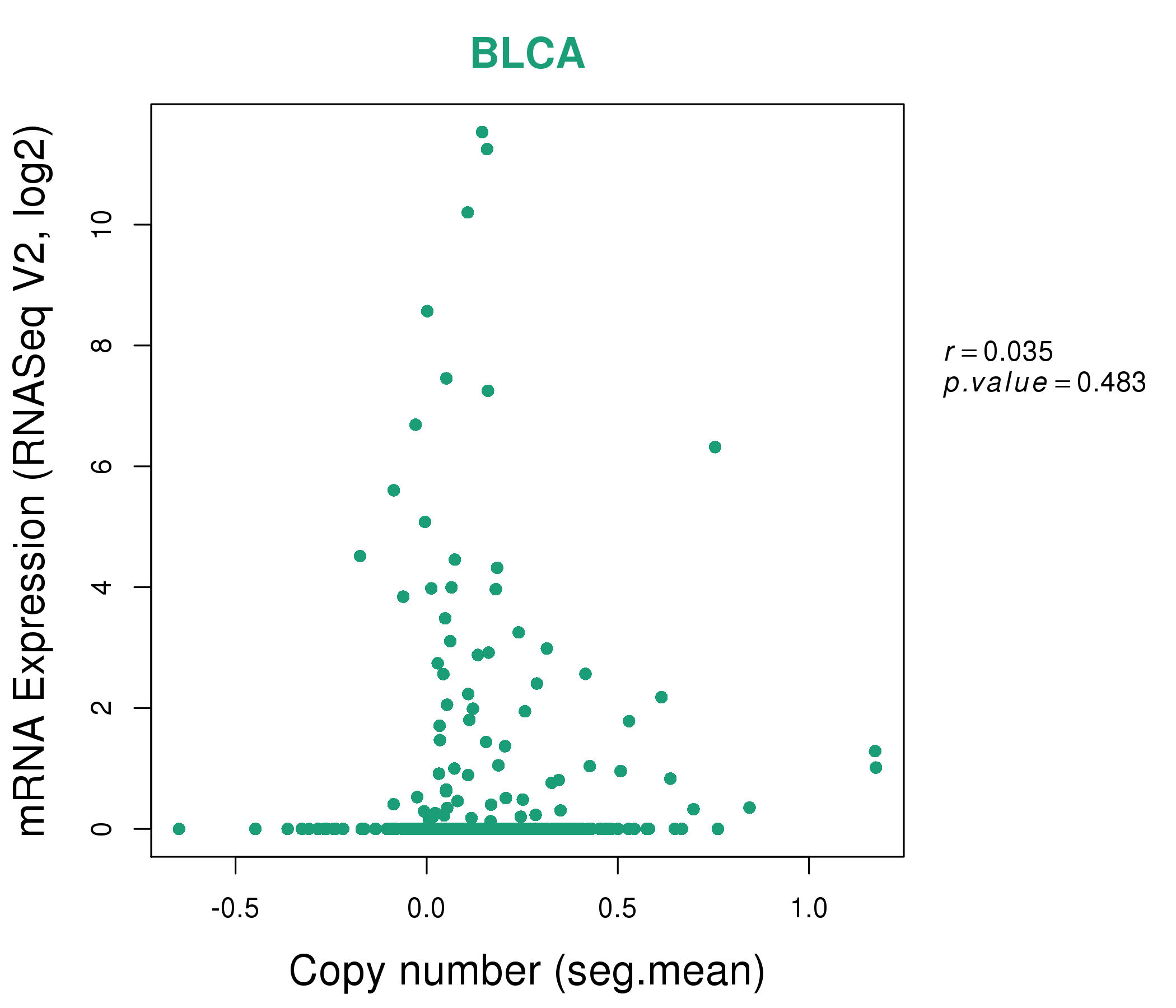 |
|
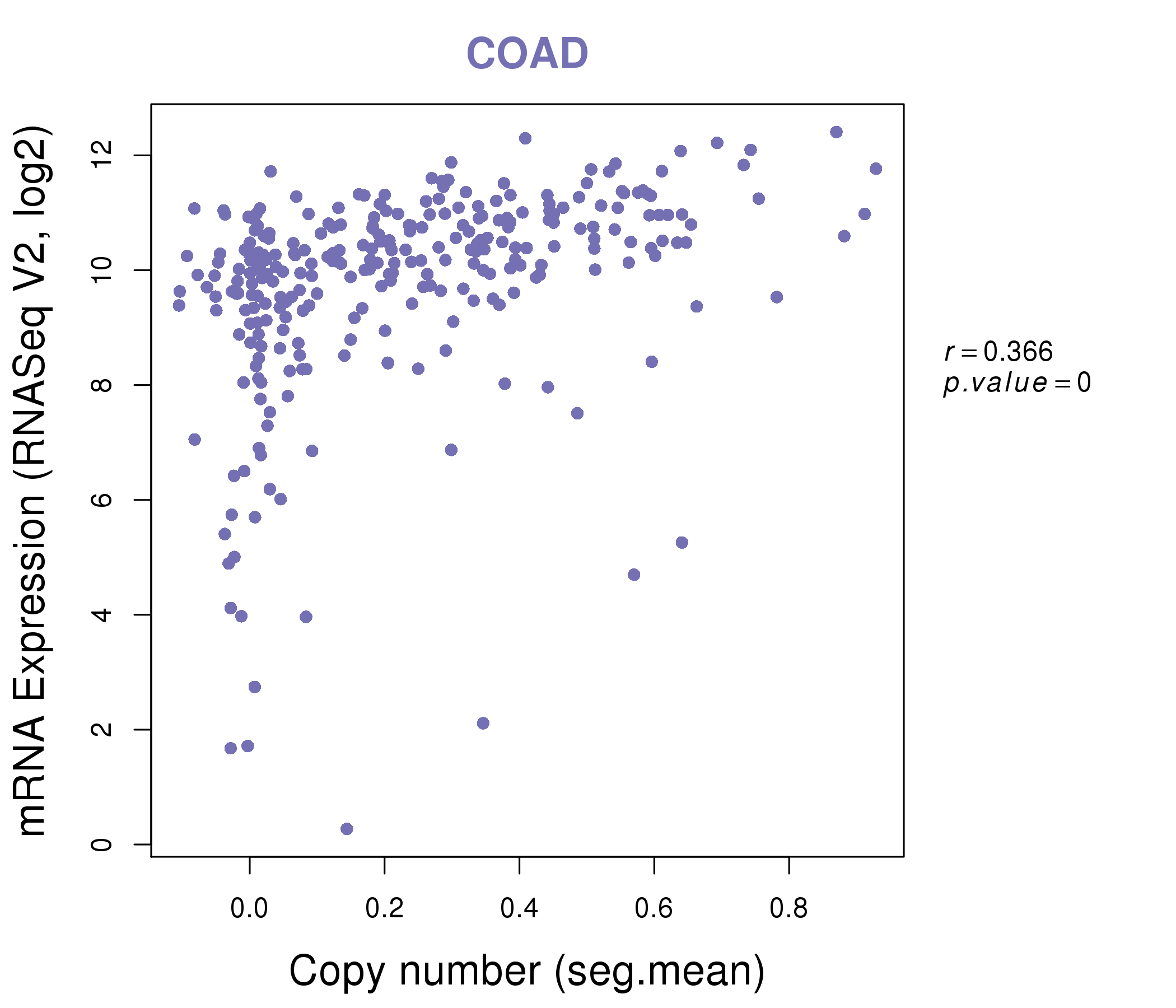 |
|
| Top |
| Gene-Gene Network Information |
| * Co-Expression network figures were drawn using R package igraph. Only the top 20 genes with the highest correlations were shown. Red circle: input gene, orange circle: cell metabolism gene, sky circle: other gene |
: Open all plots for all cancer types
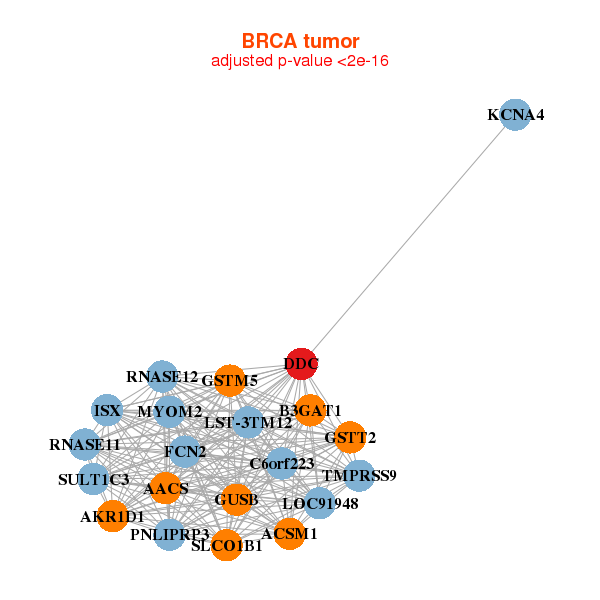 |
| ||||
| AACS,ACSM1,AKR1D1,B3GAT1,C6orf223,DDC,FCN2, GSTM5,GSTT2,GUSB,ISX,KCNA4,LOC91948,LST-3TM12, MYOM2,PNLIPRP3,RNASE11,RNASE12,SLCO1B1,SULT1C3,TMPRSS9 | ABCC12,ACSM1,ADCY10,AKR1D1,C15orf43,CTNNA2,DDC, ELOVL7,EPS8L3,HIST1H2AG,HIST1H2BJ,HIST1H3G,IYD,LOC285692, OR10A7,OR10S1,OR52E8,RIMS1,SLC12A3,SLC26A6,ZP2 | ||||
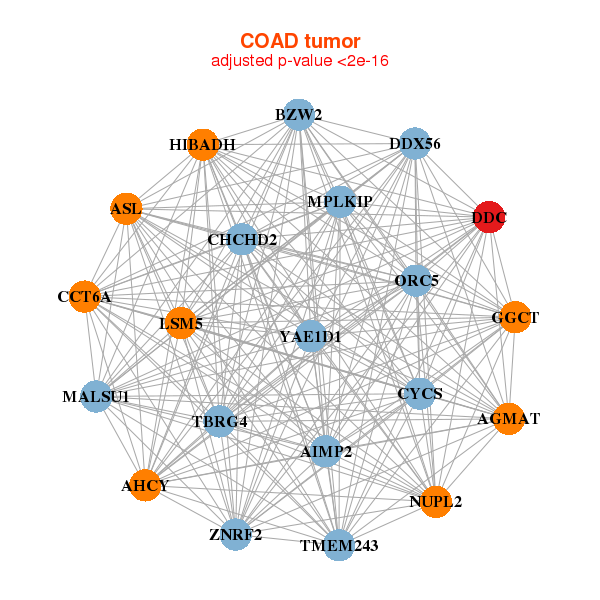 |
| ||||
| AGMAT,AHCY,AIMP2,ASL,BZW2,MPLKIP,TMEM243, MALSU1,YAE1D1,CCT6A,CHCHD2,CYCS,DDC,DDX56, GGCT,HIBADH,LSM5,NUPL2,ORC5,TBRG4,ZNRF2 | ACY1,CHN2,CLDN15,CYP2J2,DDC,DHRS4L2,EPHX2, GOLT1A,HNF4G,LOC201651,LRRC28,MACC1,MMEL1,MS4A8, MYO1A,OTC,PCK2,PTGR1,SLC2A9,SLC37A4,AGMO |
| * Co-Expression network figures were drawn using R package igraph. Only the top 20 genes with the highest correlations were shown. Red circle: input gene, orange circle: cell metabolism gene, sky circle: other gene |
: Open all plots for all cancer types
| Top |
: Open all interacting genes' information including KEGG pathway for all interacting genes from DAVID
| Top |
| Pharmacological Information for DDC |
| DB Category | DB Name | DB's ID and Url link |
| * Gene Centered Interaction Network. |
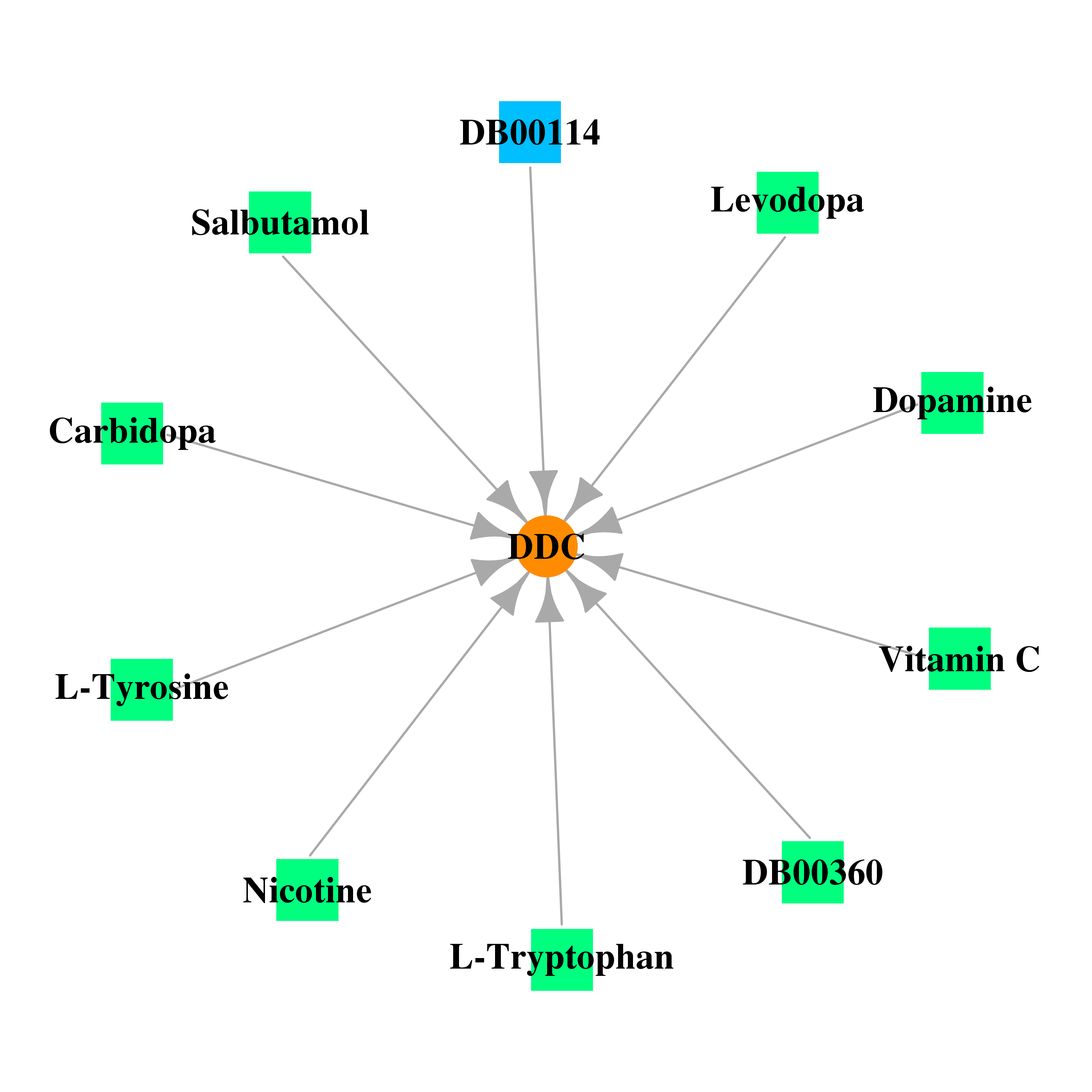 |
| * Drug Centered Interaction Network. |
| DrugBank ID | Target Name | Drug Groups | Generic Name | Drug Centered Network | Drug Structure |
| DB00114 | dopa decarboxylase (aromatic L-amino acid decarboxylase) | nutraceutical | Pyridoxal Phosphate | 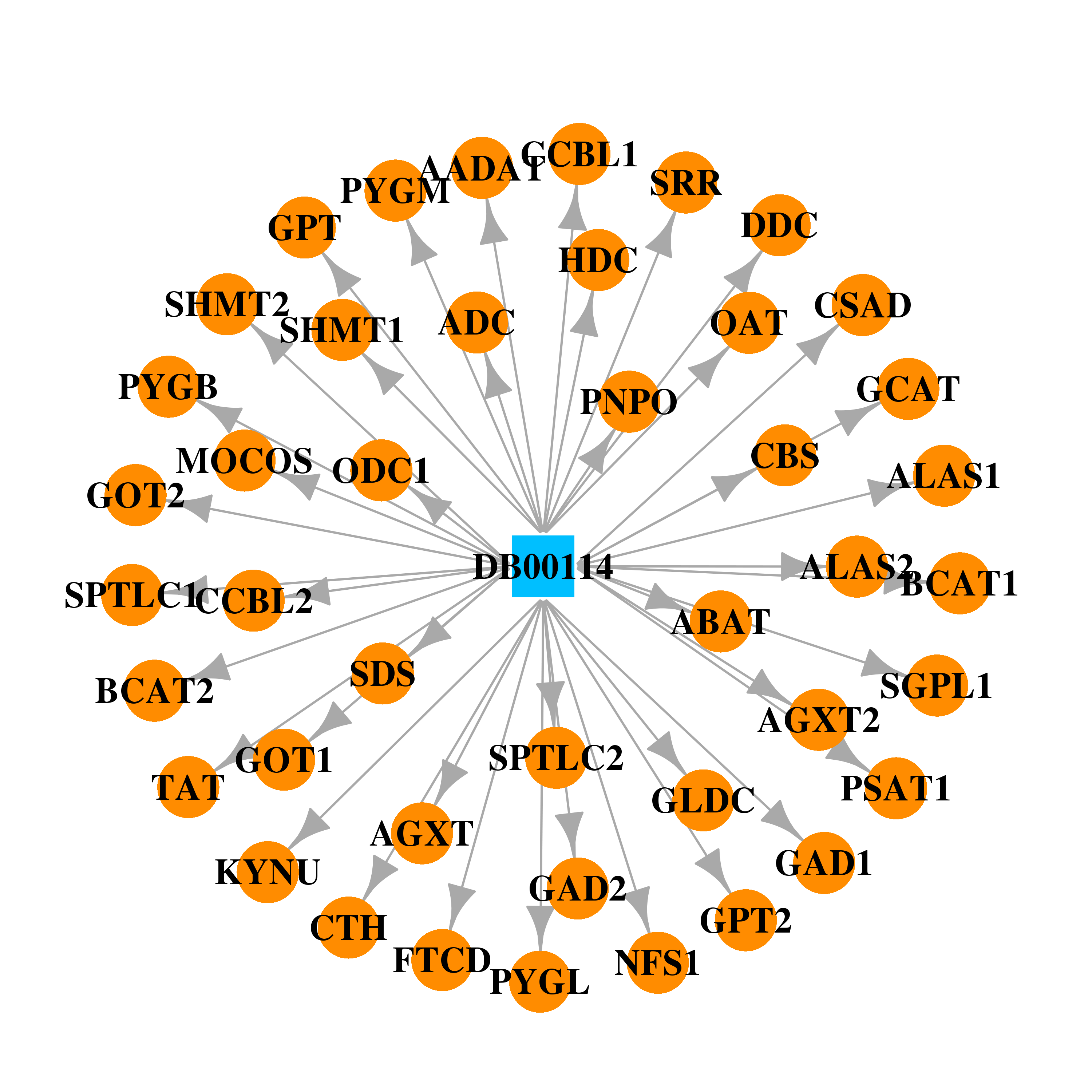 | 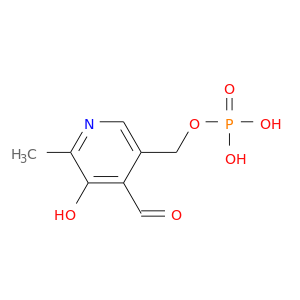 |
| DB00190 | dopa decarboxylase (aromatic L-amino acid decarboxylase) | approved | Carbidopa | 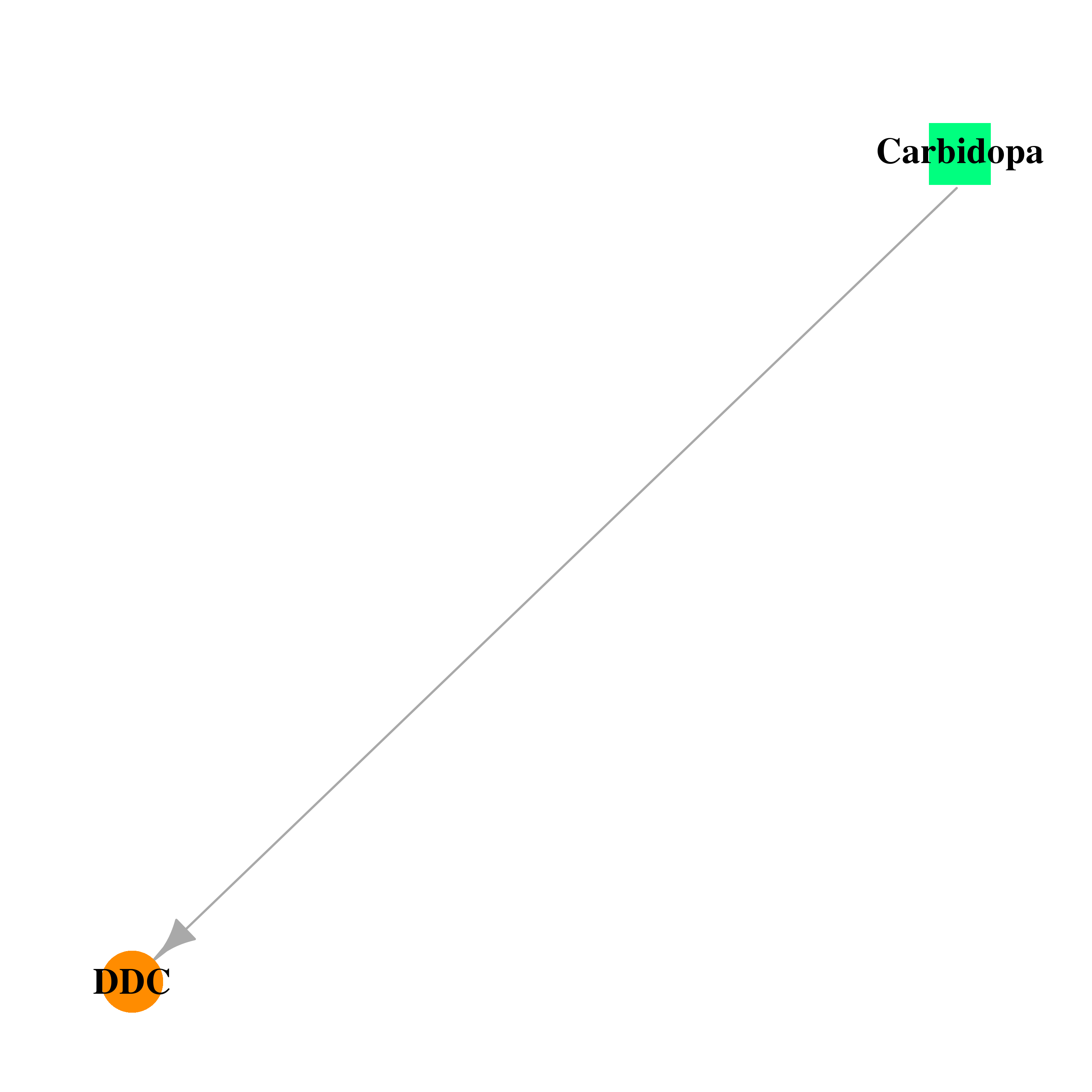 |  |
| DB00126 | dopa decarboxylase (aromatic L-amino acid decarboxylase) | approved; nutraceutical | Vitamin C | 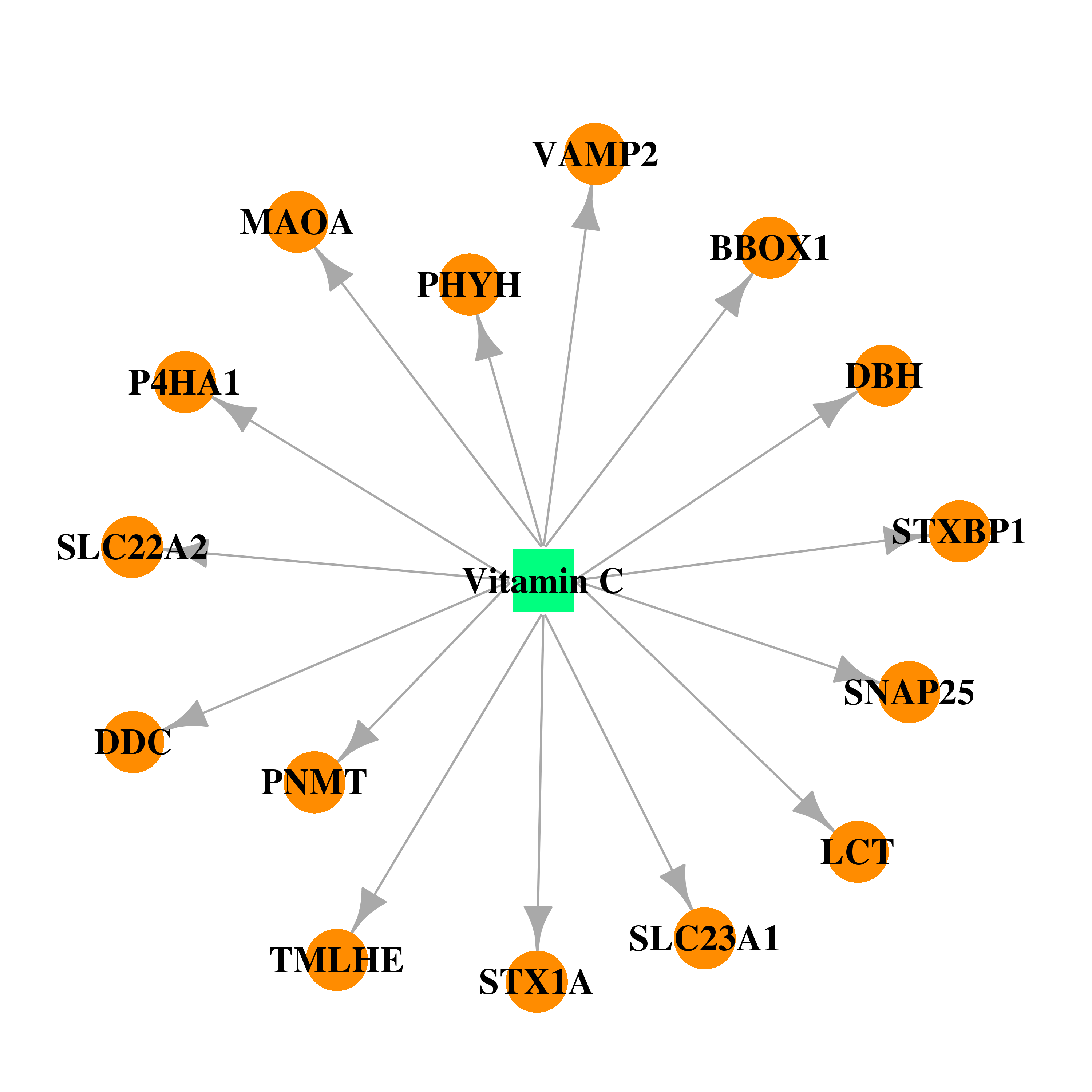 | 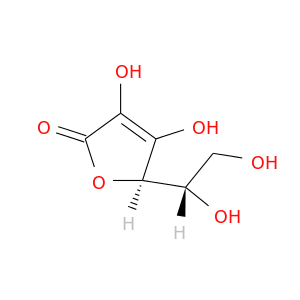 |
| DB00184 | dopa decarboxylase (aromatic L-amino acid decarboxylase) | approved | Nicotine |  | 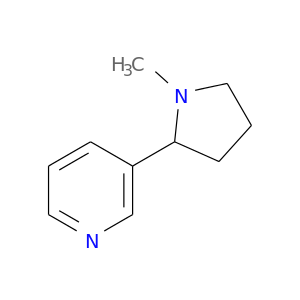 |
| DB01235 | dopa decarboxylase (aromatic L-amino acid decarboxylase) | approved | Levodopa | 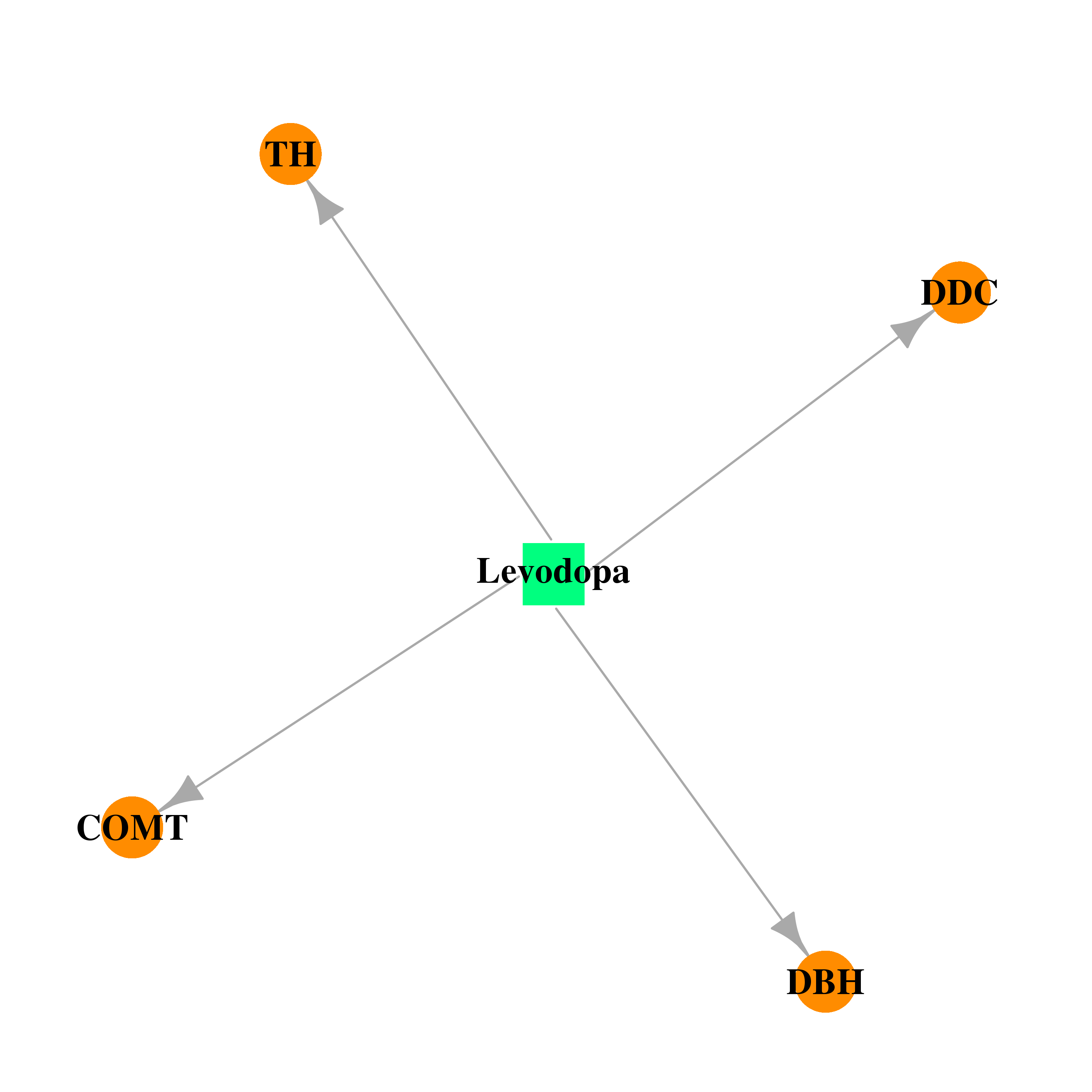 | 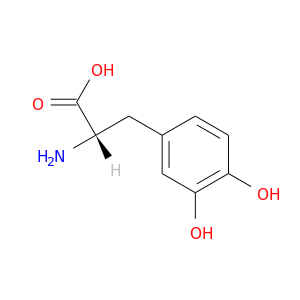 |
| DB00988 | dopa decarboxylase (aromatic L-amino acid decarboxylase) | approved | Dopamine | 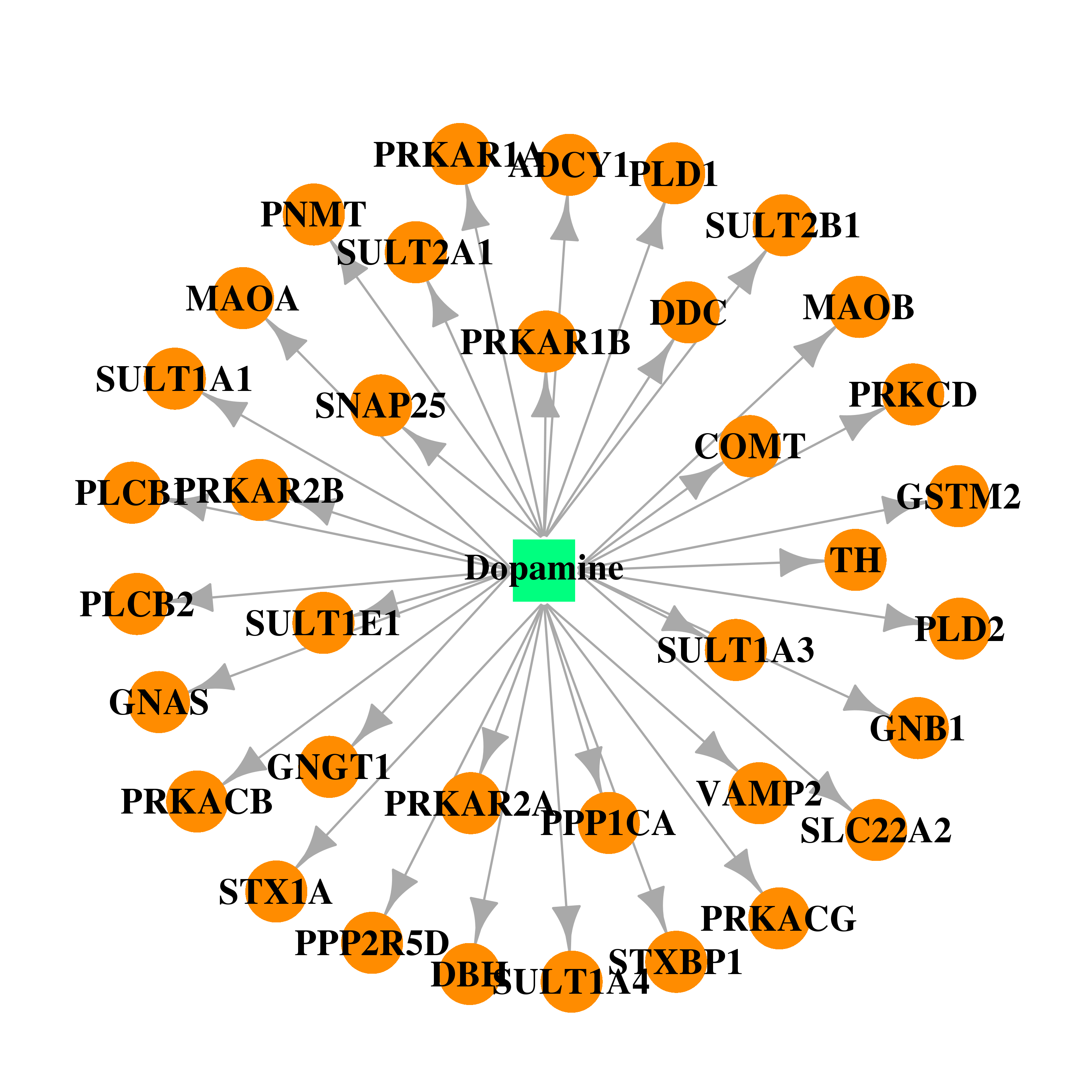 | 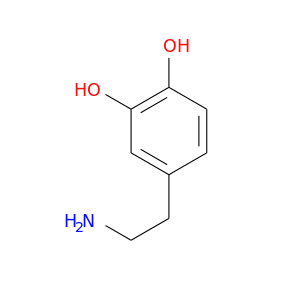 |
| DB00135 | dopa decarboxylase (aromatic L-amino acid decarboxylase) | approved; nutraceutical | L-Tyrosine |  | 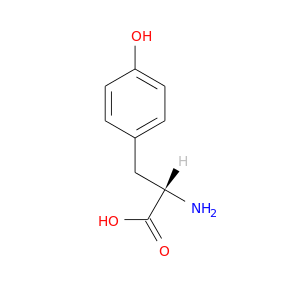 |
| DB00360 | dopa decarboxylase (aromatic L-amino acid decarboxylase) | approved; investigational | Tetrahydrobiopterin | 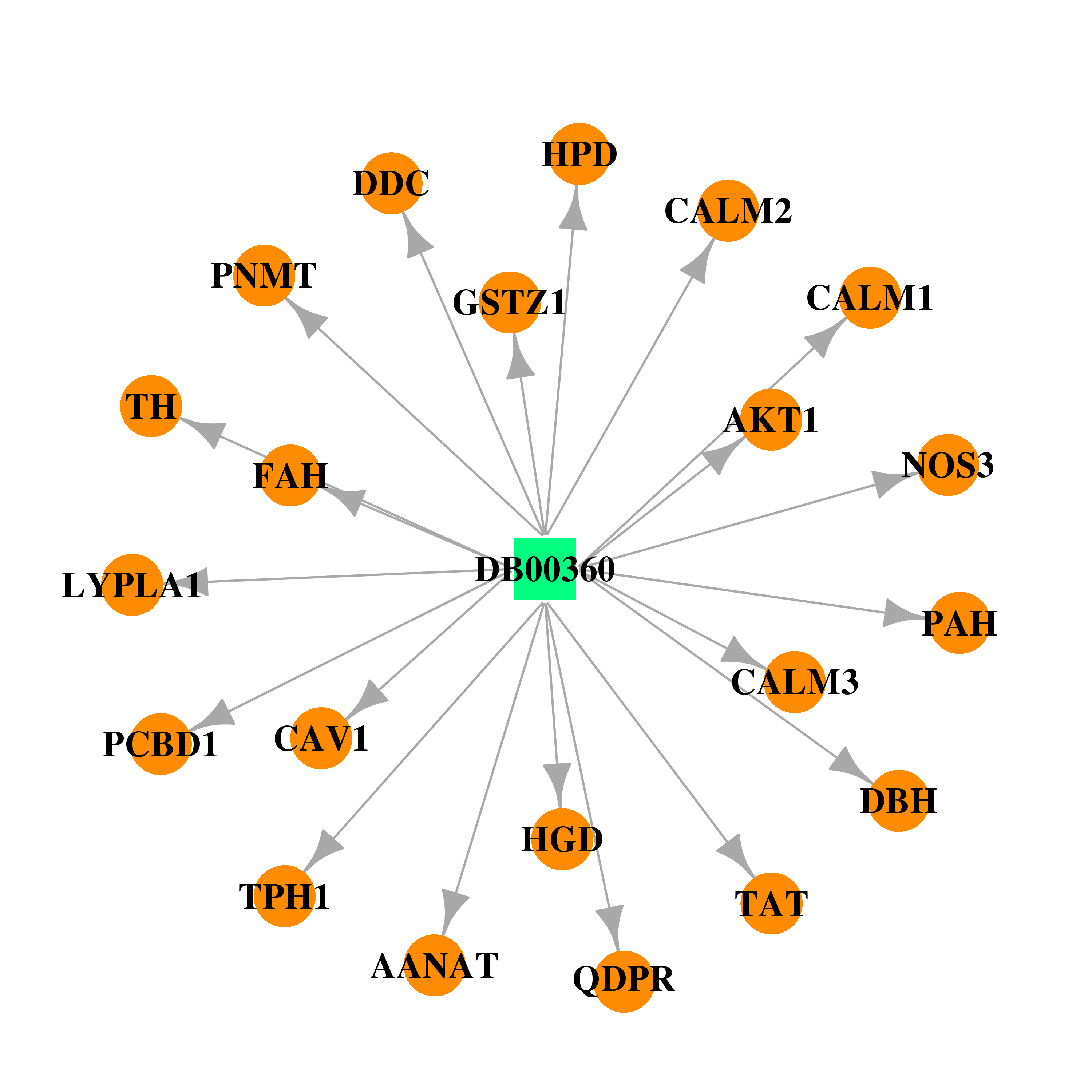 | 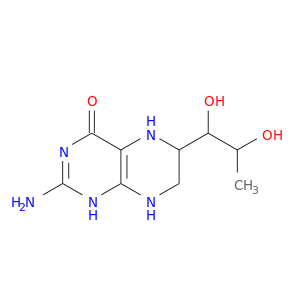 |
| DB00150 | dopa decarboxylase (aromatic L-amino acid decarboxylase) | approved; nutraceutical | L-Tryptophan | 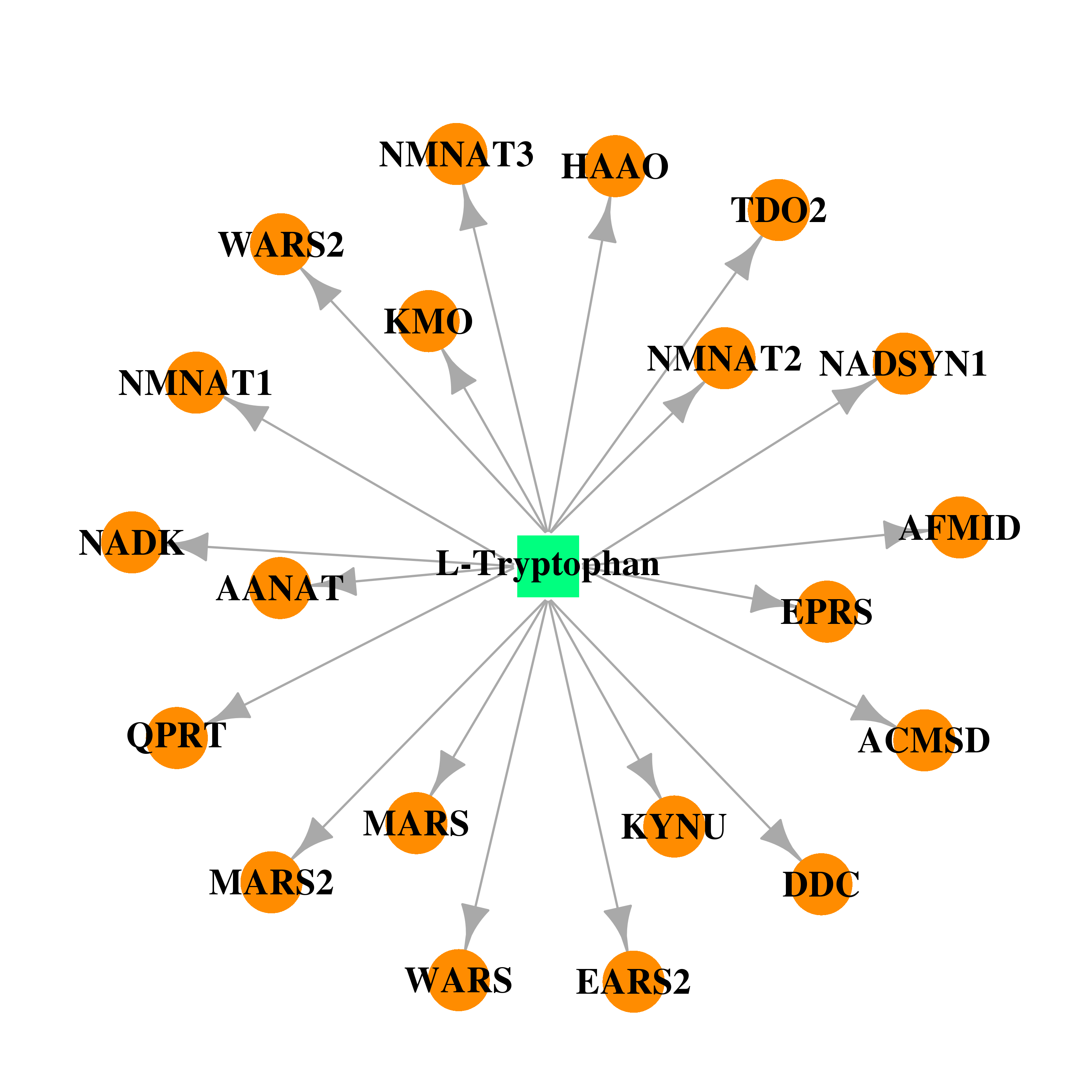 | 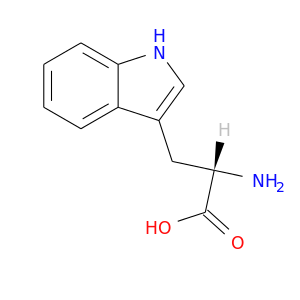 |
| DB01001 | dopa decarboxylase (aromatic L-amino acid decarboxylase) | approved | Salbutamol |  | 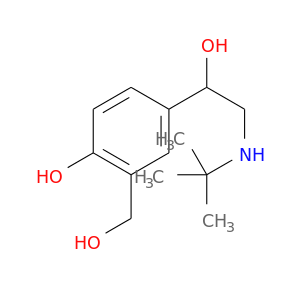 |
| Top |
| Cross referenced IDs for DDC |
| * We obtained these cross-references from Uniprot database. It covers 150 different DBs, 18 categories. http://www.uniprot.org/help/cross_references_section |
: Open all cross reference information
|
Copyright © 2016-Present - The Univsersity of Texas Health Science Center at Houston @ |






